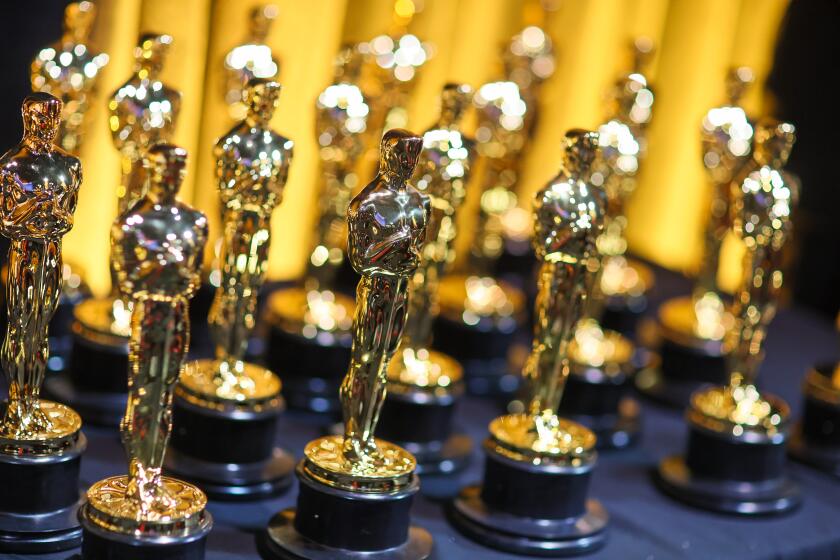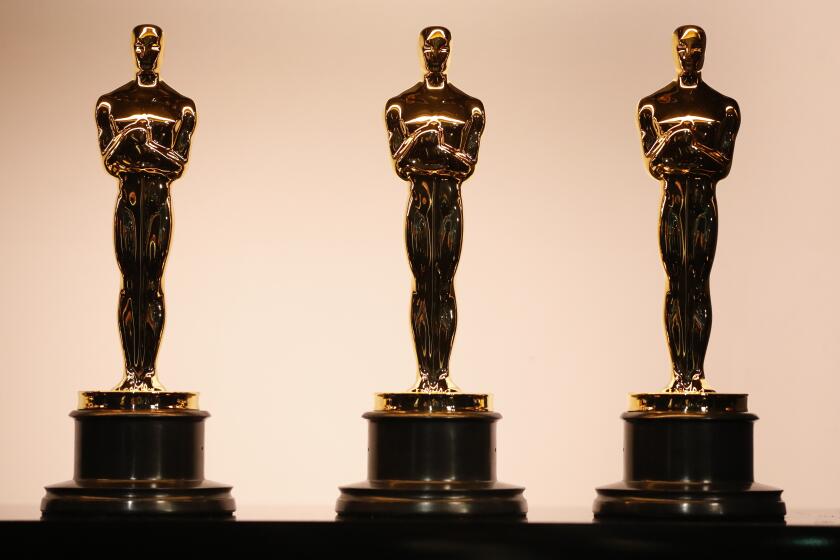Humor on Currin’s Palette Imparts Power to His Work
- Share via
Comedy has been essential to drama and literature ever since people started telling stories to one another. It’s also an important component of movies and television. But it has never played a major role in the visual arts, especially in the Western tradition, which often takes itself too seriously. If you limit yourself to the last century, you’d be hard pressed to name a single painter whose oeuvre is based in comedic principles.
At 40, John Currin is well on his way to changing that. For the last 10 years, the New York painter has been exhibiting domestically scaled pictures that demonstrate the breadth and depth of his talents--which are dazzling--and comedy’s capacity to say something significant about the strange times in which we live.
A diabolical blend of sarcasm and sweetness suffuses Currin’s early works, which depict impossibly proportioned men and women in illogical situations that make sense in spite of themselves. The faithfully rendered yet weirdly exaggerated expressions on their faces make it very hard to know whether they’re dumb as stumps or wise in some home-grown way. Cluelessness and insight are never far apart in Currin’s deliciously skewed pictures.
Painted with greater sophistication, his recent works are less wicked and more potent. At Regen Projects, four new oils on canvas give fascinating form to a peculiarly middle-class sense of being uncomfortable in one’s body and unsure of the role one is supposed to play in public.
Adolescent awkwardness takes shape in the biggest painting, an image of two naked boys who have caught so many fish there’s almost no room left in their little blue boat. Their muscular backs and dimpled buttocks occupy most of the foreground. As they wrestle with a rope and a net in which one is entangled, their arms, hands and fingers form a serpentine spiral that makes your head spin with erotic energy. Currin shows his manners by leaving the position of the boys’ legs to your imagination: Under the pile of slippery fish, they must form a fleshy pretzel.
In another painting, a gay couple strikes a pose typical to small-town portrait photography. As one man uses the other as a backrest, you can almost hear them say “cheese.” But the fidgety discomfort Currin captures in their rosy faces suggests that they can’t believe they’re acting just like the people they once despised: heterosexual couples whose lives are so comfortable they might as well be advertisements.
A third shows an effeminate man getting ready to go out for the evening. Dressed in a velvety fur-lined coat, he holds his jaw shut, smiles unconvincingly and makes an emphatic “Who me?” gesture with his delicate hands. Although his body fills the entire canvas, you can’t help but feel that he’s standing before a full-length mirror, practicing postures and expressions to see if any make him look less painfully self-conscious.
His desire to please is as touching as his nervousness is palpable. Currin’s painting is heartbreaking because it’s clear that this man knows he’s not fooling anyone, least of all himself. But the prospect of almost certain failure doesn’t stop him.
That’s what’s amazing about all of Currin’s paintings. Although they call to mind a laundry list of historical precedents, including Cranach, Tiepolo, Boucher, Fragonard, Courbet, Sargent and Eakins, they get you to root for them as if they were underdogs. That’s profoundly American and a mark of Currin’s originality.
Regen Projects, 629 N. Almont Drive, L.A., (310) 276-5424, through July 31. Closed Sundays and Mondays.
*
Price Purges Anxiety and Sets Libidos Free
Surrealism linked sex and anxiety so inextricably that modern art has not fully recovered from their coupling. The advertising industry hasn’t helped: Using sex to sell everything under the sun, it has created a few generations of artists who are suspicious of all forms of pleasure, especially ones that excite--and satisfy--erotic desire.
At L.A. Louver Gallery, a gorgeous exhibition of 10 salacious sculptures by Ken Price shows the 67-year-old artist to be a man with mission: breaking up the relationship between sex and anxiety in order to make the world safe for hedonism.
In the U.S., hedonism has a bad name. It’s ordinarily treated as a mindless diversion that’s better left to decadent playboys than pursued by serious artists. But Price makes it the focus of his abstract sculptures, which redeem hedonism from puritan narrow-mindedness by taking viewers back to classical antiquity, where philosophic contemplation and shameless pleasure were not opposed to each other.
As inspired by animated cartoons and California car culture, Price’s tabletop sculptures are covered with multicolored metallic finishes that put many painters to shame. All inhabit a world in which the libido has been set free. Your mind has to move nimbly to keep up.
The plump protrusions and inviting orifices in “Off Color,” “Marmaduke” and “Plushous” simultaneously resemble buttocks, breasts, legs, jowls, noses and more. Seamlessly fusing male and female forms, they stimulate category-defying desires and make a virtue of polymorphous perversity.
“Gorilla Ed” and “Red Neck” are softball-size orbs from which five or six fat fingers emerge. Some of these reach outward as if to explore their surroundings, like the antennae of sea creatures. Others curl back to rejoin the orb. Mocking the idea that art provides disinterested pleasures, these hilarious pieces put tongue-in-cheek onanism on display. They satisfy a lot more than themselves.
The five remaining sculptures resemble lava landscapes beneath the surfaces of which lie thinly veiled references to previous masterpieces. “Toots” is a futuristic version of Rodin’s “Burghers of Calais.” And Brancusi’s fused figures haunt “Izaak,” “Sourpuss” and “Kabongy Balls.” These links to art history are not the first thing you notice about Price’s wildly accessible art. Rather than overshadowing it, they make it even sexier.
L.A. Louver Gallery, 45 N. Venice Blvd., Venice, (310) 822-4955, through July 27. Closed Sundays and Mondays.
*
Gallace’s Paintings Pull You in for Close-Up View
Imagine a world in which every blade of grass, grain of sand and gust of wind is as riveting as a perfectly composed poem. That’s the world that takes shape in Maureen Gallace’s page-size paintings of blocky little buildings in the New England countryside. At Michael Kohn Gallery, five new oils on panel fill a rear gallery with so much to see and even more to think about that you find yourself wishing the room were bigger.
True to their size, Gallace’s paintings are intimate. They draw viewers in for one-on-one encounters. Up close, you savor the brushwork--the delicate dabs, deliberate strokes and wet-on-wet smears the New York painter uses to build her carefully wrought, casually expansive pictures of an empty road, a red barn, a hilltop house, a seaside cottage and a pair of sheds on the shore of a rocky inlet.
In the past, Gallace painted on canvas, the weave of which gave her images a knobby solidity. The smoothly sanded panels that form the grounds of her new works allow for greater fluidity and airiness. When you catch yourself staring at a single brush stroke and paying attention to the paths traveled by individual hairs of the brush, you know you’re hooked.
Gallace doesn’t make a big fuss about such refined pleasures. She lays them out for herself and ignores uninterested viewers. This sort of leave-you-alone stoicism is refreshing, especially in contemporary art, which tends to attract obnoxious proselytizers.
She applies paint swiftly and decisively. Everything feels as if it has been carefully mulled over and then done, matter-of-factly and wholeheartedly. There’s no room for regrets in her seemingly simple works, which don’t mess around with adjustments and compromises.
Crystal-clear about what they are up to, Gallace’s paintings do not embody the process of thinking out loud--of trying ideas out, getting some feedback and proceeding accordingly. On the contrary, they’re utterly resolved. Unlike most intimate art, which invites you to enter the interior world of its maker, hers occupies the fully visible world of shared social space. It holds up from all the way across the gallery, whose walls prevent you from testing just how powerful her little pictures are.
Michael Kohn Gallery, 8071 Beverly Blvd., L.A., (323) 658-8088, through July 9. Closed Sundays and Mondays.
*
Mullican’s Vibrant Works Defy the Passage of Time
At Grant Selwyn Fine Art, a terrific exhibition of paintings and drawings by Lee Mullican (1919-1998) picks up where his last gallery show left off: charting a chronological course through his estate, still a treasure trove of little-known riches and secret delights.
In 1999, a similar survey focused on works the Oklahoma-born artist made in San Francisco between 1948 and 1957, after he was discharged from the Army. As a soldier, Mullican drew topographical maps from aerial photographs. His job influenced his art, which often resembles bird’s-eye views of fragmented landscapes.
The current survey begins in 1957 and ends in 1963. It features the first works Mullican made after moving to Los Angeles in 1961 to teach at UCLA.
These paintings fall into two groups: large, roughly square canvases painted in a narrow range of bright yellows and slightly smaller orange ones whose wider range of tints includes burnt sienna, dirty beige, earthy brown, smoky black and a few blazing yellow highlights.
They’re among his most minimal works. But that doesn’t mean they’re simple. To make each, Mullican first painted irregular patterns in two or three similar shades. Their interlocked shapes recall camouflage. He then dipped the edge of a palette knife into a pool of thick paint and pressed it to the canvas. This basic gesture left a little ridge of wet paint that dried to form a solid line. When Mullican repeated it thousands of times, a shallow relief resulted.
Think of Morse code crossed with Braille. This gives you an idea of the look and the feel of his abstract images, which, properly speaking, have as much to do with printmaking as they do with traditional painting.
They’re also sculptural, or interactive. Catching slivers of ambient light and casting thin shadows, they create flickering fields of oddly modulated color. Some anticipate the look of heat-sensitive imaging. Most are right at home with some of the best art being made today, in which futuristic digital imagery intermingles with such old-fashioned materials as paint and canvas.
A second gallery displays five medium-size paintings Mullican made in 1957 and 1958. It’s hard to believe they’re that old. Their sorbet palettes, whimsical compositions and slippery surface effects make them look very today.
Grant Selwyn Fine Art, 341 N. Canon Drive, Beverly Hills, (310) 777-2400, through July 20. Closed Sundays and Mondays.
More to Read
The biggest entertainment stories
Get our big stories about Hollywood, film, television, music, arts, culture and more right in your inbox as soon as they publish.
You may occasionally receive promotional content from the Los Angeles Times.










